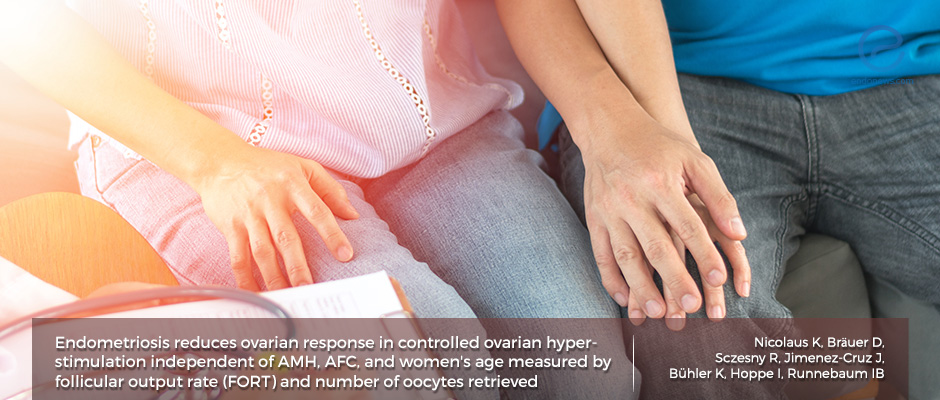Endometriosis and ovarian reserve
Jan 14, 2020
The follicular output rate (FORT) and the number of metaphase-II oocytes decrease due to endometriosis, regardless of age, antral follicle count and anti-Müllerian hormone.
Key Points
Highlights:
- The ovarian response in infertile women with endometriosis in controlled ovarian hyperstimulation is negatively influenced independently of age, antral follicle count and anti-Müllerian hormone.
Importance:
- Women with endometriosis should be appropriately informed before controlled ovarian hyperstimulation about decreased ovarian response regardless of age, antral follicle count and serum anti-Müllerian hormone level.
What’s done here?
- This retrospective cohort study was conducted in the Department of Gynaecology and Reproductive Medicine, Jena University Hospital, Deutschland.
- Two hundred and five intracytoplasmic sperm injection (ICSI) cycles performed in 96 women following controlled ovarian hyperstimulation protocols were analyzed, 26 were with endometriosis.
- Women who were younger than 43 years and underwent controlled ovarian hyperstimulation following a GnRH-antagonist protocol were included.
- FORT was used to assess the ovarian response to controlled ovarian hyperstimulation. This term was identified as the ratio of pre-ovulatory follicle (16–22 mm in diameter) count on the day of HCG and small antral follicle count at baseline.
- The measurement of serum anti-Müllerian hormone was performed within 3 months prior to ovarian stimulation.
- Age, antral follicle count, body mass index, serum follicle-stimulating hormone, and anti-Müllerian hormone levels were determinants for the selection of protocols.
Key results:
- There was no statistically significant difference regarding age, age at menarche, average menstrual cycle length, body mass index, duration of infertility, or type of infertility, serum anti-Müllerian hormone level, basal follicle-stimulating hormone level, thyroid-stimulating hormone level, and antral follicle count between the groups with and without endometriosis.
- The FORT, number of retrieved oocytes, number of metaphase II oocytes, and the fertilization rate were significantly lower in the endometriosis group.
- There was no association between the number of retrieved oocytes, FORT, and endometriosis with the demographic and clinical characteristics of women such as age, antral follicle count, and anti-Müllerian hormone level.
Limitations
- The retrospective and monocentric case-control design can be accepted as the limitations of this study.
- Laparoscopy was not performed in all patients in the control group.
Lay Summary
Endometriosis is most frequently encountered in reproductive-aged women. Its prevalence is 10-15% in the general population of this age. However, endometriosis is diagnosed more frequently in infertile women with a prevalence of 25-40%.
Although the exact mechanism explaining the association between endometriosis and infertility has not been elucidated, distorted pelvic anatomy, impaired ovarian function, altered microenvironment, affected endometrial receptivity, and embryo quality been accepted as the most common responsible mechanisms.
Infertility in women with endometriosis is managed most commonly by assisted reproductive technology (ART) modalities. The outcomes of in vitro fertilization (IVF) is correlated with the ovarian reserve and the number and quality of retrieved oocytes following controlled ovarian hyperstimulation. Ovarian reserve can be assessed using serum hormone levels such as follicle-stimulating hormone (FSH), anti-Müllerian hormone (AMH) and antral follicle count (AFC) measured by transvaginal ultrasonography.
Nicolaus et al, a group of scientists from Germany, published a study titled as “Endometriosis reduces ovarian response in controlled ovarian hyperstimulation independent of AMH, AFC, and women’s age measured by follicular output rate (FORT) and number of oocytes retrieved” in the journal named "Archives of Gynecology and Obstetrics". These authors sought to evaluate the ovarian response in women with endometriosis following controlled ovarian hyperstimulation.
They included 205 ICSI cycles in 96 women. They compared the ovarian response using follicular output rate (FORT) and the number of retrieved oocytes between infertile women with endometriosis (n=26) and those without endometriosis (n=70). There was no statistically significant difference between patients in terms of their demographic and clinical characteristics. The FORT, number of retrieved oocytes, number of metaphase II oocytes, and the fertilization rate were significantly lower in women with endometriosis independent of AMH, AFC, and women’s age.
“Our results could be used in clinical practice to inform and counsel couples before ART, especially for patients with advanced age,” they added.
Research Source: https://www.ncbi.nlm.nih.gov/pubmed/31667607
endometriosis follicular output rate ovarian response retrieved oocytes controlled ovarian hyperstimulation

